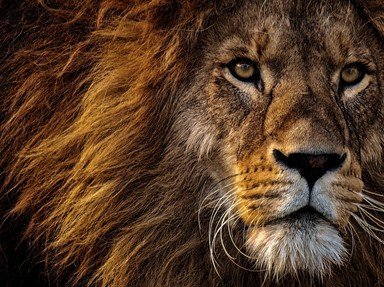Quiz Answer Key and Fun Facts
1. What is the binomial name for the lion?
2. Female and male lions have different characteristics based on their gender. This is described as being what?
3. What is the lion's typical habitat?
4. The mane is one of the most distinctive features of a lion. Do all adult male lions have a mane?
5. The white lion has a genetic condition known as what?
6. Lions are typically inactive for approximately how many hours per day?
7. Meat makes up more than seventy percent of a lion's diet, making them which of these?
8. Where they share territory, this animal often competes with lions for prey. What is it?
9. Approximately how long is a gestation period for the lion?
10. Lions communicate using a number of different behaviours that include head rubbing, vocal noises and this response, nicknamed the 'grimace face.' What is this called?
Source: Author
ramonesrule
This quiz was reviewed by FunTrivia editor
rossian before going online.
Any errors found in FunTrivia content are routinely corrected through our feedback system.

